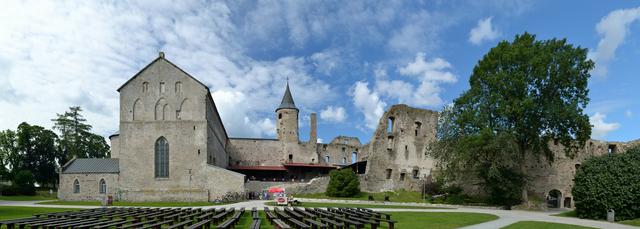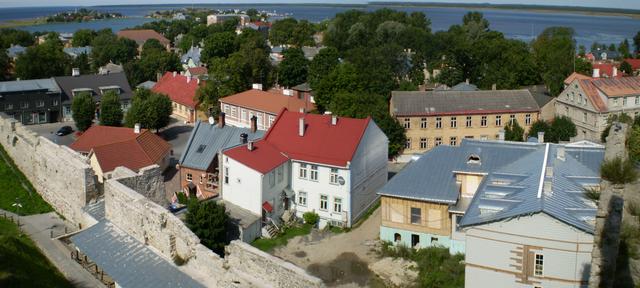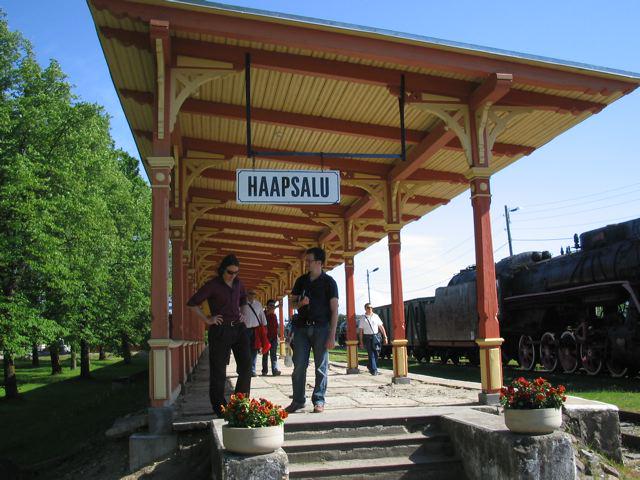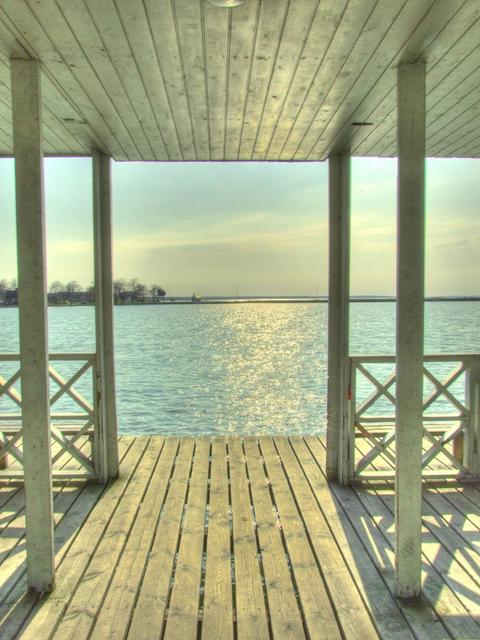Haapsalu is a major seaside resort town on the west coast of Estonia, approximately 100 km south-west of Tallinn.
 Haapsalu was chartered in 1279 and is well known for its historic and maritime ambience, warm sea water, curative mud baths and friendly residents. It's a wonderful little town with narrow streets for families and romantic couples who enjoy having picnics, walking, visiting spas and taking mud baths, sailing and swimming.
Haapsalu was chartered in 1279 and is well known for its historic and maritime ambience, warm sea water, curative mud baths and friendly residents. It's a wonderful little town with narrow streets for families and romantic couples who enjoy having picnics, walking, visiting spas and taking mud baths, sailing and swimming.
- Tourist Information Centre, Karja 15, +372 4733248. M–F 9–17:00, Sa–Su 10–16:00.
Tourist Information Centre, Karja 15, +372 4733248. M–F 9–17:00, Sa–Su 10–16:00.

- Haapsalu Bishop’s Castle and Cathedral, Lossiplats tn 3, +372 5184664, + 372 4737065. F–Sa 10–14:00, Su 11–15:00. The Haapsalu Bishop’s Castle and Cathedral, which was established in the 13th century as the centre of the Saare-Lääne Diocese, is one of the best preserved castles in Estonia. Visit the museum complex in the convent building where you will find exhibition halls with finds from the castle and mysterious vaulted cellars. You might encounter Estonia’s most famous ghost – the White Lady.
- Haapsalu Maria-Magdaleena Church, Rüütli tn 2, +372 4737211, +372 53015251. The Estonian Orthodox Maria Magdaleena Church is located in an idyllic area of Haapsalu – on the Promenade. The church was restored to its present state only a few years ago.
- Haapsalu Resort Hall, Promenaadi tn. The timber-laced Resort Hall and the Bandstand on the seaside Promenade were built at the end of the 19th century and are the only ones of the kind that have survived in their original form. The Resort Hall is today, and was in the first half of the 20th century, the centre of summer activities in Haapsalu.
- Kiltsi airfield, Kiltsi küla, Ridala vald. Built by former Soviet Union army Kiltsi airfield extends to ca 800 ha area. Concrete runways are 2500 m long, for the airplanes there were 28 hangars. Adventure searchers should be careful in the military settlement and, to avoid possible collapses, not to scale the ruins. Apparently also sometimes used for drag racing.
- Ungru Manor, Kiltsi küla, Ridala vald. The ruins of the Ungru manor used to represent one of the most impressive Neo-Baroque buildings in Estonia, although it was never really finished. The contrasting Soviet airfield remains next to the manor.

- Haapsalu Old Town Hall Museum, Kooli tn 2, +372 4737065. The museum is located in the former Town Hall in Lossiplatsi Square. Wander through the historic interior and learn about the old times of Haapsalu. Exhibitions change regularly, so depending when you come you might get to know the old farmhouse, the once-famous resorts of Haapsalu, or the ancient history of the area.
- Haapsalu Railway Station/Museum, Raudtee tn 2, +372 4734574. The Haapsalu Station building was custom designed, because the resort town was a favourite holiday site for the Russian tsars. The complex has four parts – the passenger building, Imperial Pavilion, the colonnade connecting them, and a unique 216-metre-long covered platform. To see historic engines and carriages look behind the train station. The railway station was also sometimes used in making movies.
- Museum of the Coastal Swedes, Sadama tn 31 - 32, +372 4737165. Tu–Sa 10–18:00, Su–M 10–16:00. The museum introduces the thousand-year-old settlements of the coastal Swedes in Estonia. In the house inaugurated by the King of Sweden, you can acquaint yourself with their unique cultural heritage and see a 20-metre embroidered rug that depicts the life of the Estonian-Swedes.
- Cyrillus Kreek Apartment Museum, Väike-Viigi tn 10 / 2. Cyrillus Kreek (1889-1962) is known as the composer of choral works and was beloved by the people of Haapsalu. The permanent exposition introduces the composer's life and works. Have a cup of coffee or tea at the museum and listen to the composer's music.
- Haapsalu Shawl Museum, Ehte tn 4. The Haapsalu Shawl, an extremely fine knitted shawl that can be pulled through a woman's ring, has been the symbol of Haapsalu since the last century. In the Shawl Museum, which is located in a jewellery workshop, you can see a permanent exhibition on the past and present of the Haapsalu shawl, examine the extremely fine patterns, and buy one of the masterpieces.
- Communication Museum, Tamme tn 21. Communication Museum offers a review of the development of telecommunications in Western Estonia.
Haapsalu Old Town Hall Museum, Kooli tn 2, +372 4737065. The museum is located in the former Town Hall in Lossiplatsi Square. Wander through the historic interior and learn about the old times of Haapsalu. Exhibitions change regularly, so depending when you come you might get to know the old farmhouse, the once-famous resorts of Haapsalu, or the ancient history of the area.
Haapsalu Railway Station/Museum, Raudtee tn 2, +372 4734574. The Haapsalu Station building was custom designed, because the resort town was a favourite holiday site for the Russian tsars. The complex has four parts – the passenger building, Imperial Pavilion, the colonnade connecting them, and a unique 216-metre-long covered platform. To see historic engines and carriages look behind the train station. The railway station was also sometimes used in making movies.
Museum of the Coastal Swedes, Sadama tn 31 - 32, +372 4737165. Tu–Sa 10–18:00, Su–M 10–16:00. The museum introduces the thousand-year-old settlements of the coastal Swedes in Estonia. In the house inaugurated by the King of Sweden, you can acquaint yourself with their unique cultural heritage and see a 20-metre embroidered rug that depicts the life of the Estonian-Swedes.
Cyrillus Kreek Apartment Museum, Väike-Viigi tn 10 / 2. Cyrillus Kreek (1889-1962) is known as the composer of choral works and was beloved by the people of Haapsalu. The permanent exposition introduces the composer's life and works. Have a cup of coffee or tea at the museum and listen to the composer's music.
Haapsalu Shawl Museum, Ehte tn 4. The Haapsalu Shawl, an extremely fine knitted shawl that can be pulled through a woman's ring, has been the symbol of Haapsalu since the last century. In the Shawl Museum, which is located in a jewellery workshop, you can see a permanent exhibition on the past and present of the Haapsalu shawl, examine the extremely fine patterns, and buy one of the masterpieces.
Communication Museum, Tamme tn 21. Communication Museum offers a review of the development of telecommunications in Western Estonia.
Haapsalu Bishop’s Castle and Cathedral, Lossiplats tn 3, +372 5184664, + 372 4737065. F–Sa 10–14:00, Su 11–15:00. The Haapsalu Bishop’s Castle and Cathedral, which was established in the 13th century as the centre of the Saare-Lääne Diocese, is one of the best preserved castles in Estonia. Visit the museum complex in the convent building where you will find exhibition halls with finds from the castle and mysterious vaulted cellars. You might encounter Estonia’s most famous ghost – the White Lady.
Haapsalu Maria-Magdaleena Church, Rüütli tn 2, +372 4737211, +372 53015251. The Estonian Orthodox Maria Magdaleena Church is located in an idyllic area of Haapsalu – on the Promenade. The church was restored to its present state only a few years ago.
Haapsalu Resort Hall, Promenaadi tn. The timber-laced Resort Hall and the Bandstand on the seaside Promenade were built at the end of the 19th century and are the only ones of the kind that have survived in their original form. The Resort Hall is today, and was in the first half of the 20th century, the centre of summer activities in Haapsalu.
Kiltsi airfield, Kiltsi küla, Ridala vald. Built by former Soviet Union army Kiltsi airfield extends to ca 800 ha area. Concrete runways are 2500 m long, for the airplanes there were 28 hangars. Adventure searchers should be careful in the military settlement and, to avoid possible collapses, not to scale the ruins. Apparently also sometimes used for drag racing.
Ungru Manor, Kiltsi küla, Ridala vald. The ruins of the Ungru manor used to represent one of the most impressive Neo-Baroque buildings in Estonia, although it was never really finished. The contrasting Soviet airfield remains next to the manor.
 Haapsalu is a seaside resort and one of the main attractions is the beach. Famous mud baths can be taken in numerous facilities in Haapsalu.
Haapsalu is a seaside resort and one of the main attractions is the beach. Famous mud baths can be taken in numerous facilities in Haapsalu.
The town is also well known for its White Lady Days, Old Music Festival, Violin Festival and the August Blues Festival.
- Africa Beach and Promenade, Promenaadi tn. Walk on the sloping promenade and glance dreamily at the sea; check the time at the sundial and have a rest on the bench named for the world-famous composer Tchaikovsky. There is a children's playground on the Promenade and the town’s only observation tower.
- Swedish Market, Karja tn 1. Haapsalu's main street, Karja Street, begins on the Swedish Market. The fountain side is a nice and romantic place to sit.
Africa Beach and Promenade, Promenaadi tn. Walk on the sloping promenade and glance dreamily at the sea; check the time at the sundial and have a rest on the bench named for the world-famous composer Tchaikovsky. There is a children's playground on the Promenade and the town’s only observation tower.
Swedish Market, Karja tn 1. Haapsalu's main street, Karja Street, begins on the Swedish Market. The fountain side is a nice and romantic place to sit.
- Hesburger, Jaama 32. M–Su 09–22:00. Finnish fast food chain.
- Peetri Pizza, Tallinna mnt 1, +372 58667078. Su–Th 10–20:00, F–Sa 10–05:00. pizzeria
Hesburger, Jaama 32. M–Su 09–22:00. Finnish fast food chain.
Peetri Pizza, Tallinna mnt 1, +372 58667078. Su–Th 10–20:00, F–Sa 10–05:00. pizzeria
- Pärnu – Estonia's 4th largest city and the summer capital of Estonia, popular for its balneo-therapy complexes and spa centres, surrounded by numerous beaches.
- Noarootsi – A bilingual municipality: Estonian and Swedish. Step into Swedish and Soviet history.
- Hiiumaa – The second largest Estonian island. Popular for its lighthouses, ancient churches, historical values and the sense of humour of its inhabitants, but scarcely populated. In winter, it can sometimes be reached by car via an ice bridge on the Baltic Sea.
- Saaremaa – The largest Estonian and wild seaside character island with castles and fortresses, one perfectly preserved, a beach, a spa and famous mills. Saaremaa is even sometimes called Sparemaa. Furthermore, the island itself is surrounded by a myriad of tiny islands including Abruka with its nudist camps.
